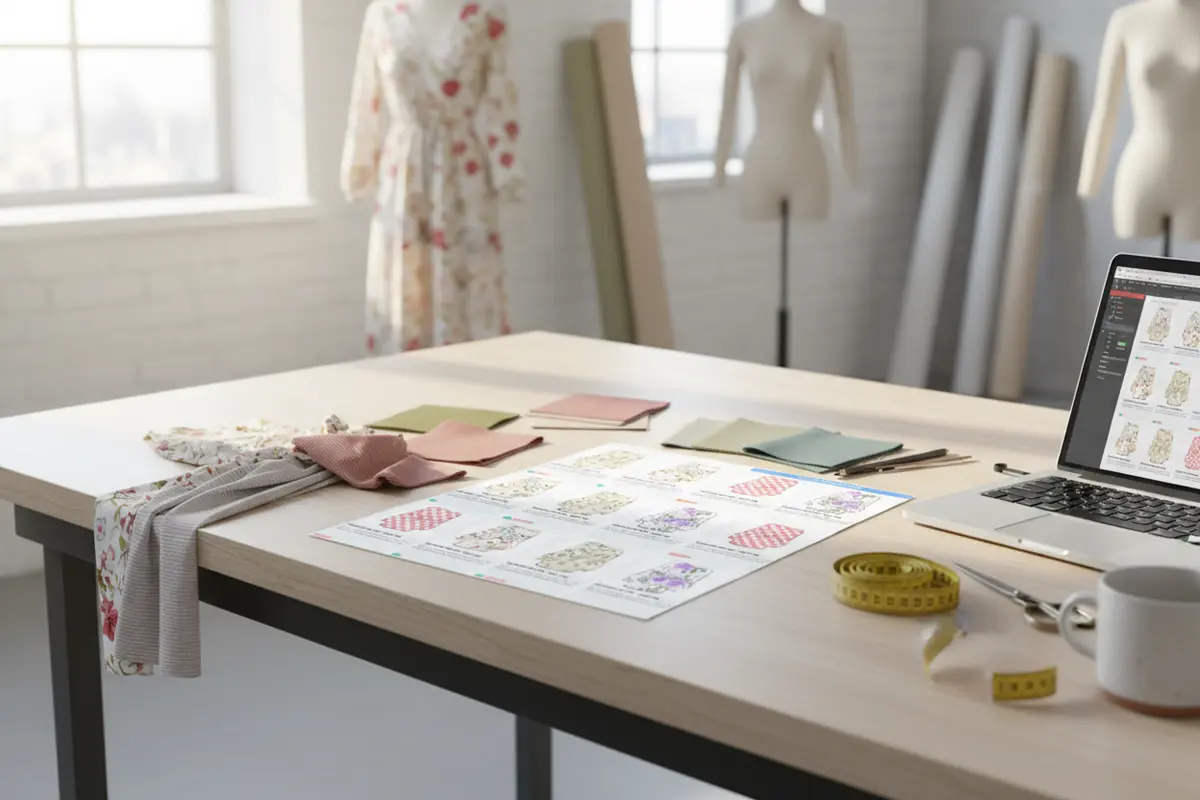
1. What Is a Line Sheet?
A line sheet or line list is a core marketing and sales document that every fashion business needs. It serves as a bridge between your brand and potential buyers, showing product details, pricing, and ordering options in a simple and structured way. When you attend trade shows or reach out to retail customers, your line sheet becomes the visual representation of your collection. It is what buyers rely on to make informed purchasing decisions.
In essence, a fashion line sheet is both a catalog and a communication tool. It helps retailers understand what styles are available, how much each item costs, and when they can expect delivery. A well designed line sheet allows you to sell efficiently and make a lasting impression on potential buyers who often have to review hundreds of product lines in a single season.
For many growing brands, creating line sheets manually can seem like a daunting task. However, technology has simplified this process dramatically. With modern PLM systems, fashion companies can store all the information—materials, colors, style numbers, and pricing—in one place and easily create digital line sheets. These digital formats update automatically, allowing for real time updates and eliminating manual edits. This automation ensures that every printed or online version is accurate, professional, and aligned with your brand identity.
The difference between a line sheet and a sell sheet lies in purpose. A sell sheet is promotional and often targets retail customers, while a line sheet focuses on wholesale buyers and B2B sales. Similarly, a lookbook highlights your brand story with lifestyle photography, whereas a line sheet provides detailed product data to help buyers place orders directly.
2. What Should Be Included in a Line Sheet
A great line sheet balances design and function. The goal is to make it easy for buyers to review your collection and place orders. A well designed layout uses high quality images, clear typography, and precise product details without clutter.
Below are the essential components of a professional wholesale line sheet:
|
Section |
Details to Include |
|---|---|
|
Product Images |
Use high quality images that show the product from different angles and in good lighting |
|
Style Name & Number |
Include a unique code or name to identify each product easily |
|
Sizes & Colors |
List all available sizes and color variations clearly |
|
Fabric or Material |
Mention the type of fabric, composition, or special materials used |
|
Wholesale Prices |
Provide accurate wholesale prices and quantity options |
|
Retail Price |
Add suggested retail prices to guide retailers |
|
Delivery Window |
Specify delivery dates or shipping windows |
|
Contact Information |
Add your brand’s email, phone number, and order form link |
|
Minimum Order Quantities |
Indicate the minimum order quantities or conditions |
Every line sheet should also include simple, concise product descriptions that give enough detail without overwhelming the page. Make sure your pricing and sizing details are consistent across all pages to build trust and clarity with buyers.
Pro Tip: Keep your design clean and minimal. Retailers prefer a simple layout where images and data speak for themselves. A consistent template across all your collections enhances brand recognition and makes updating future versions easier.
3. The Ideal Line Sheet Format
The line sheet format determines how smoothly buyers can navigate your content. The most common formats are printed PDF line sheets and digital line sheets created via PLM software.
|
Format Type |
Description |
Best For |
|
PDF Line Sheet |
Easy to print or attach in emails, ideal for trade shows and in-person presentations |
Buyers who prefer printed references |
|
Digital Line Sheet |
Created and hosted online via PLM or showroom platforms with real time updates on retail price |
Remote buyers and international partners |
Printed line sheets remain an important part of fashion trade, especially when attending physical events. They give a tangible feel to your product line and can include QR codes or website links to digital catalogs for further exploration. On the other hand, digital formats provide flexibility, sustainability, and instant accessibility. With just one link, buyers can browse updated styles and place orders directly.
When creating line sheets, consistency is key. Use the same product grid layout across pages, maintain equal image dimensions, and align columns neatly. Always include page numbers, your logo, and contact details on each page. High quality images with simple backgrounds make your sheet stand out and ensure it looks professional in both printed and digital forms.
PLM automation tools simplify this entire process by pulling product data—such as stock, materials, and pricing—directly into the layout. As soon as your design or price changes, the PLM updates your line sheet automatically, saving hours of manual work and reducing human error.
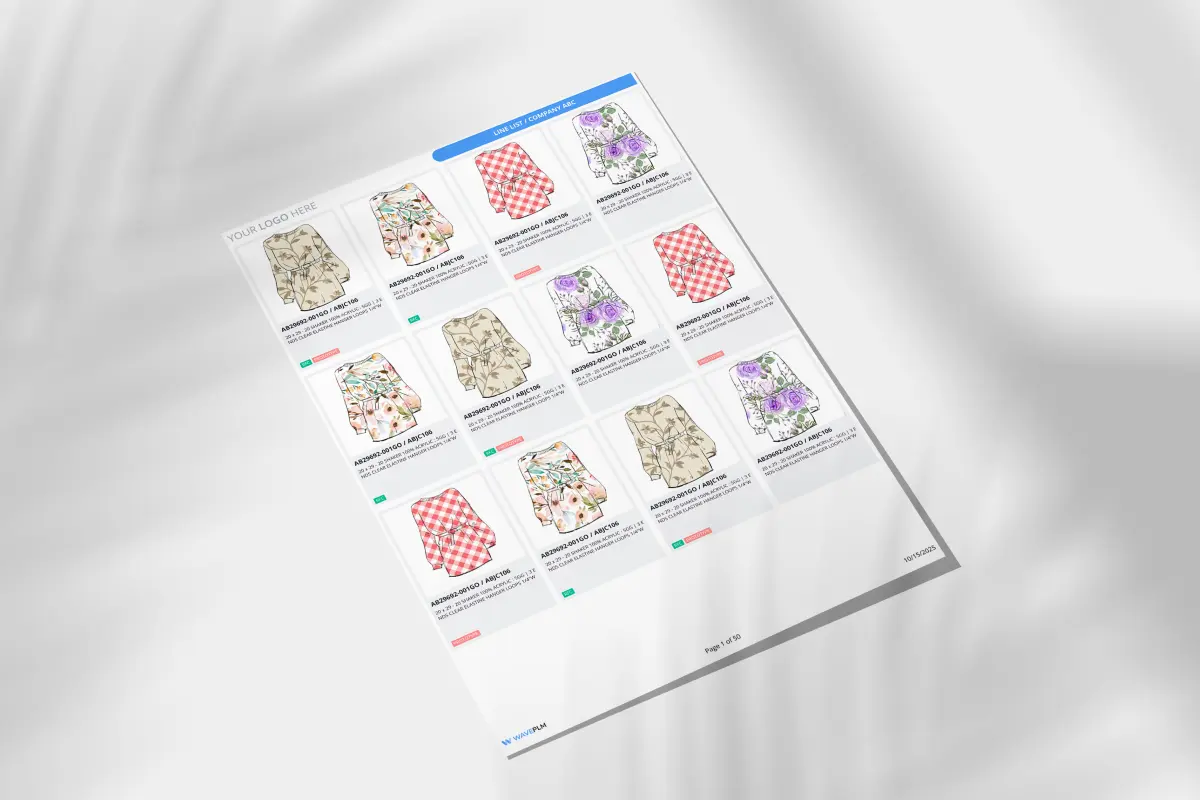
4. Line Sheet Template Examples
A structured line sheet template is the foundation of an efficient sales document. Templates ensure consistency, professionalism, and ease of use for your team. Below is an example format you can follow when creating line sheets for your brand.
|
Section |
Description |
|
Header |
Include your logo, collection name, season, and page number |
|
Product Grid |
Display each item with image, SKU, product name, colors, sizes, and wholesale prices |
|
Footer |
Add ordering information, minimum order quantities, terms, and contact details |
Example Line Sheet Layout
Header:
Logo | Collection Name | Season | Page Number
Product Table:
|
Image |
Style # |
Product Name |
Color |
Size Range |
Fabric |
Wholesale |
Retail |
Delivery |
|
101 |
Linen Shirt |
White |
S-XL |
100% Linen |
$45 |
$110 |
March 2026 |
|
|
102 |
Denim Jacket |
Blue |
XS-L |
Cotton Blend |
$75 |
$165 |
April 2026 |
|
|
103 |
Silk Blouse |
Rose |
XS-XL |
100% Silk |
$85 |
$195 |
May 2026 |
Footer:
To place an order, email: orders@yourbrand.com
Minimum order: 20 units | Payment terms: Net 30 days
Website: www.yourbrand.com
A template like this keeps your presentation organized and repeatable. Once set up, you can reuse it each season with updated product details. If your company uses Wave PLM, the system can generate line sheet templates automatically and sync them with your product catalog for real time updates.
5. Why Use PLM for Line Sheet Creation
Many fashion businesses still rely on spreadsheets and manual design tools to create their line sheets. This approach not only takes time but also increases the risk of mistakes. A PLM line sheet, however, simplifies the process and ensures every detail stays consistent across your organization.
|
Benefit |
Description |
|
Real Time Updates |
Updates appear instantly whenever pricing or style data changes |
|
Data Accuracy |
Eliminates the risk of outdated information between departments |
|
Streamlined Communication |
Connects design, production, and sales teams for faster collaboration |
|
Consistency |
Keeps branding uniform across every sheet and catalog |
|
Collaboration |
Allows multiple users to edit and approve updates efficiently |
With PLM integration, you can manage your entire product lifecycle—from concept to sale—in one platform. You can store materials, product descriptions, and pricing data centrally, then export fashion wholesale tools like digital line sheets, lookbooks, and catalogs directly. This ensures that everyone from designers to sales reps works from the same accurate data source.
Moreover, PLM systems improve communication between departments, ensuring streamlined communication that reduces delays. They provide visibility across design, manufacturing, and sales stages, allowing teams to make informed decisions faster. These advantages translate to fewer errors, quicker production cycles, and more confident selling.
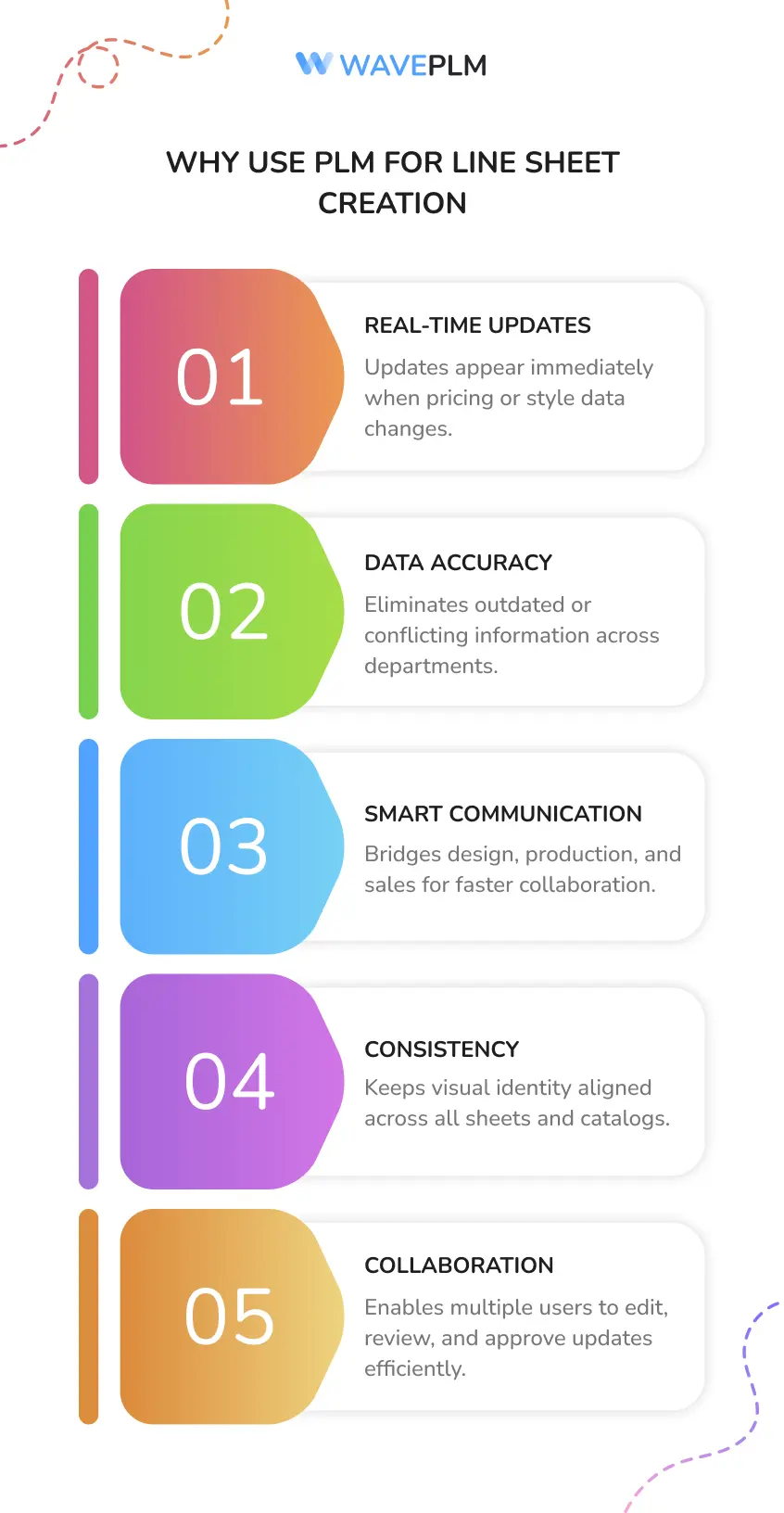
6. Conclusion: Simplify Presentation, Amplify Sales
Creating a professional line sheet is an essential step for any fashion business that wants to grow its wholesale network. Whether you choose printed or digital formats, your goal is to help buyers understand your brand quickly and easily. A clear layout, high quality images, and well-organized product details make a lasting impression.
By using PLM tools like Wave PLM, you can easily create professional, accurate, and branded wholesale line sheets without the manual effort. Every update made in your design or pricing database reflects instantly in your presentation documents, ensuring that buyers always see the latest version.
Investing in an efficient line sheet process not only helps you sell but also strengthens your business credibility. In a competitive market, presentation matters. When your line sheets look professional and informative, retailers trust your brand more and are more likely to place orders directly.
Quick Takeaway
|
Step |
Action |
Tool |
|
1 |
Collect all product data and visuals |
PLM system |
|
2 |
Choose your line sheet format |
PDF or Digital |
|
3 |
Apply a professional line sheet template |
Wave PLM or custom layout |
|
4 |
Review product descriptions, pricing, and contact information |
Internal QA |
|
5 |
Share your sheet |
Email, showroom, trade fair, or website |
Simplify your presentation, connect with retailers, and amplify your sales results. Your next collection deserves a polished, great line sheet that showcases your creativity, quality, and professionalism to the world.

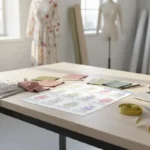

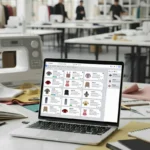

Leave a Reply